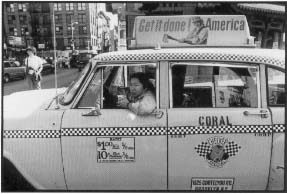Museums and Exhibitions in New York City and Vicinity
| Home | | Museum Guide | | International | | Architecture & Design | | Theater |
Photography Review: "Not on the Menu: From Asian/Pacific Islander Roots to American Reality" by Corky Lee
 |
| An Asian woman cabbie was the poster image of "Not on the Menu: From Asian/Pacific Islander Roots to American Reality" by Corky Lee. |
"Not on the Menu: From Asian/Pacific Islander Roots to American Reality"
Photos by Corky Lee
Museum of Chinese in the Americas (MoCA), 70 Mulberry Street, 2nd Floor
212-619-4785
May 3-November 30, 2001
Reviewed by Emily Morris July 25, 2001.
Deep in the heart of Chinatown, photojournalist Corky Lee is hiding his tribute
to the Asian Pacific immigrants of America. If you can find the Museum of Chinese
in the Americas (MoCA) on the second floor of the building at 70 Mulberry Street
(meaning, you might not just stumble across it), there is a beautiful collection
of over forty of Lee's black and white prints.
Lee has been determinedly chronicling New York's Asian American community for over thirty years. Born a second-generation Chinese American in Queens the son of an immigrant laundryman, Lee has been crafting his art as a "personal crusade" documenting local history, sometimes with an ironical twist. One of the most memorable photos is a friend of Lee's imitating Lady Liberty on a street corner in Chinatown holding a copy of the New York Times.
Apart from what the title connotes, there is no distinct theme for the exhibit, "Not on the Menu: From Asian/Pacific Islander Roots to American Reality." Lee wasn't biased in choosing his subjects; a Hindu couple in a Cadillac sedan shares the same wall as a photo of the first elected Chinese American governor in the United States and his first lady.
Lee blends a wonderful mixture of subject and emotions. Two of the side by side photos in the beginning are of a Japanese father helping his small son during the Obon Festival at Riverside Park, and a waiters' strike at the Silver Palace in Chinatown. Lee does the emotional searching with his lens, the viewer doesn't need to make much of an effort to understand his message and see his vision.
As with any exhibit that deals with the volatile subject of immigration, Lee acknowledges the hostilities his muses face as a minority. What struck me though was the absolute absence of resentment or bitterness in the prints. There is controversy, but he manages to capture celebration and protest in the same frame, as he did when covering the boycott/protest of National Review Magazine. The lonely oppressed is depicted in the photo of the embattled deli owner of Red Apple in Flatbush, Brooklyn with only his peace bench for company. The images are socially conscious as well as intimate.
The Asian people have undeniably faced hardships and resistance to their integration. Lee's photos depict a people that is blending the old and the new with an indefatigable spirit, from the portrait of a protective Asian member of the Guardian Angels to candid moment of a girl waiting at the door for her date on prom night. The image of the workers picketing for fairer wages testifies not only to injustices, but also to the Asians determination to share their part of the "American Dream."
Corky Lee has a gift for lending intimacy to his subject. There is no hostility in his protest, and no emotional distance. The Asians ar a large presence in America, and as a photo caption says, "they can no longer afford to be the silent majority." The "Unofficial, Undisputed Asian American Photographer Laureate" will be remembered as recording his people's history with an artistry and understanding. [E.M.]
Museums by day, theater by night. Required reading: